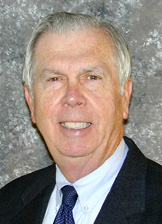Lehigh University
Office or Center Name Here
Gene Corley
Senior Vice President, CTL Group
Learning from the Attacks on an American Icon:World Trade Center Building Performance Study
click here to view video
Friday, April 20th, 2007
4:10 P.M.
Sinclair Laboratory Auditorium
Overview:
The 9-11 attacks on the World Trade Center Towers resulted in severe structural damage followed by extensive fires and complete collapse of three buildings, along with damage to other buildings by falling debris or fire. The American Society of Civil Engineers/Structural Engineering Institute immediately formed a Building Performance Study Team to learn how the buildings performed in this tragedy, Dr. Corley was asked to lead the team. This lecture describes the results of the study, and identifies approaches and other areas of study that could mitigate structural response to such severe conditions
For more than two decades, Dr. Corley has served as a researcher and consultant for building and bridge construction, and has authored over a hundred seventy articles and books dealing with the subject of structural design and behavior. Dr. Corley was Principal Investigator for the ASCE and FEMA on the investigation of the Oklahoma City Bombing and has done investigations of earthquake damage in Central America, South America, Japan, and California. Dr. Corley is an active member of the National Academy of Engineering, an Honorary Member of ASCE, and member of several other engineering societies. Currently he serves as President of the National Council of Examiners for Engineering and Surveying.
Dr. Gene Corley: W. Gene Corley is currently Senior Vice President, CTLGroup, Inc., Skokie Illinois, and is an active member of the National Academy of Engineering, an Honorary Member of ASCE, an Honorary Member of ACI, and a member of several other engineering societies. He is Past President of the National Council of Structural Engineers Associations, and past-Chairman of the ASCE Council on Forensic Engineering and of ACE-318. Currently he serves as President of the National Council of Examiners for Engineering and Surveying. He has authored over a hundred seventy articles and books dealing with the subject of structural design and behavior.
For more than two decades, Dr. Corley has served as a researcher and consultant for building and bridge construction. His expertise includes material behavior; fatigue of structural concrete; and earthquake and blast effects on buildings and bridges.
Dr. Corley was Principal Investigator for the ASCE and FEMA on the investigation of the Oklahoma City Bombing and has done investigations of earthquake damage in Central America, South America, Japan, and California. He is a Licensed Structural Engineer in Illionois, and holds Professional Engineer licenses in 25 states. Dr. Corley received his B.S., M.S., and Ph.D. degrees in Structural Engineering from the University of Illinois in Urbana.
Learning from the Attacks on an American Icon:World Trade Center Building Performance Study:
On September 11, 2001, an attack on the World Trade Center Towers resulted in severe structural damage followed by extensive fires and complete collapse of three buildings. Several other buildings were damaged by falling debris or fire. The American Society of Civil Engineers/Structural Engineering Institute immediately formed a Building Performance Study Team to learn how the buildings performed in this tragedy.
As the nation watched the attack, the following fires, and the eventual collapse of the World Trade Center Towers, the engineering community immediately began to ask questions: How were the towers able to withstand the enormous impact of a 767 without collapsing? Could anything be done to make the buildings survive longer in the ensuing fires? To help answer these questions, the American Society of Civil Engineers/Structural Engineering Institute and the Federal Emergency Management Agency joined together to study the performance of collapsed and damaged buildings at the World Trade Center site, and asked Dr. Corley to lead the team. With the cooperation of nearly a dozen other societies and organizations, this team of 23 Structural and Fire Protection Engineers completed their work on May 1, 2002.
Dr. Corley will describe the results of the study, and identifies approaches and other areas of study that could mitigate structural response to such severe conditions.
The Fazlur R. Khan Distinguished Lecture Series has been initiated and organized by Dan M. Frangopol, the first holder of Lehigh's Fazlur Rahman Khan Endowed Chair of Structural Engineering and Architecture.
